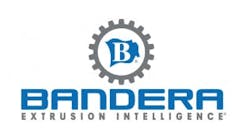Kuhne Maschinenbau, part of the Kuhne Group, is offering newly designed Smart Sheets BDFI dies with internal deckles for flat-sheet extrusion with widths up to 78.7 inches.
The name BDFI stands for Breitschlitzdüse mit Flexlippe und Internem Deckling, which in English means “extrusion die with flexible lip and internal deckles.”
The dies were designed for manufacturers of flat sheets that use low-viscosity resins, since the die outlet needs to be as close as possible to the roll nip due to the raw material’s consistency, said Thorsten Bung, director of North American sales for Kuhne Smart Sheets. PET flat-sheet producers and those using easy-flowing polyolefins could benefit from internal deckles, he said.
“The material guiding is smoother, and the die width is adjustable from outside, which improves machine downtime,” Bung said. “We can avoid process problems.”
Dies traditionally have deckles on the outside of the die. They are two metal blades that are moved manually to adjust the width of the die opening.
In the new BDFI dies, both internal blades are individually adjustable from outside and during production, according to the company.
The production of PET sheet requires a short distance between roll nip and die lip due to the melt viscosity, according to Kuhne. The slim design of the BDFI in the area of the die lips guarantees the shortest possible distance to the roll nip. With externally positioned blades, it can be difficult to obtain the same precision. Rolls could be damaged if the PET cools too early or too far away from the roll nip.
The internal deckles also help prevent melted resin from sticking inside the die.
“This protects dies and sheets from contamination of black specks,” Bung said.
Kuhne is currently looking for its first North American customer for the BDFI dies.
Bruce Geiselman, senior staff reporter
bgeiselman@plasticsmachinerymagazine.com
Contact:
Kuhne Group Sankt Augustin, Germany, 49-2241-902-147,
Bruce Geiselman | Senior Staff Reporter
Senior Staff Reporter Bruce Geiselman covers extrusion, blow molding, additive manufacturing, automation and end markets including automotive and packaging. He also writes features, including In Other Words and Problem Solved, for Plastics Machinery & Manufacturing, Plastics Recycling and The Journal of Blow Molding. He has extensive experience in daily and magazine journalism.
PTi names Ryan Pasturczak sales manager
Bandera reports cybersecurity incident
Nordson appoints regional sales manager






